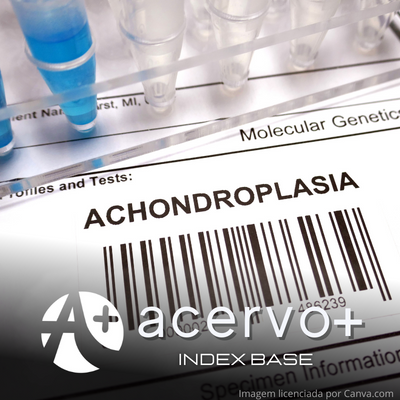Acondroplasia: uma revisão de literatura
##plugins.themes.bootstrap3.article.main##
Resumo
Objetivo: Analisar as características da Acondroplasia. Revisão Bibliográfica: A acondroplasia é uma doença genética rara reconhecida como a displasia esquelética primária mais comum em humanos. Esta forma de displasia é responsável por mais de 90% dos casos de baixa estatura desproporcional, também conhecida como nanismo. Suas características incluem baixa estatura desproporcional, encurtamento rizomélico dos membros, macrocefalia com bossa frontal, hipoplasia da face média, tórax menor que a média, cifose toracolombar, lordose lombar, articulações hipermóveis, mas com extensão e rotação limitadas do cotovelo e do quadril, apesar da frouxidão geral do quadril, arqueamento tibial e braquidactilia. Considerações finais: A acondroplasia afeta mais de 250.000 indivíduos em todo o mundo, estando relacionada a um padrão reconhecível de crescimento, complicações médicas ao longo da vida como obesidade, apneia obstrutiva do sono, estenose espinhal, sobrepeso/obesidade, dor crônica nas costas/pernas, deficiência auditiva e problemas respiratórios. Além disso, está associada a desafios funcionais e psicossociais relacionados. Nesse sentido, apesar de não haver tratamento específico para a doença, seu acompanhamento é realizado por uma equipe multidisciplinar com o objetivo de diminuir suas complicações e melhorar a qualidade de vida.
##plugins.themes.bootstrap3.article.details##
Copyright © | Todos os direitos reservados.
A revista detém os direitos autorais exclusivos de publicação deste artigo nos termos da lei 9610/98.
Reprodução parcial
É livre o uso de partes do texto, figuras e questionário do artigo, sendo obrigatória a citação dos autores e revista.
Reprodução total
É expressamente proibida, devendo ser autorizada pela revista.
Referências
2. BUCERZAN S, et al. Diagnostic, treatment and outcome possibilities in achondroplasia. Med Pharm Rep, 2021; 94(1): 22-24.
3. BHUSAL S, et al. Diagnosis of Achondroplasia at Birth: A Case Report. JNMA J Nepal Med Assoc, 2020; 58(222): 119-121.
4. CORMIER-DAIRE V, et al. The first European consensus on principles of management for achondroplasia. Orphanet J Rare Dis, 2021; 16(1): 333.
5. DEL PINO M, et al. Growth in achondroplasia, from birth to adulthood, analysed by the JPA-2 model. J Pediatr Endocrinol Metab, 2020; 33(12): 1589-1595.
6. FANO V, et al. Impact of achondroplasia on Latin American patients: a systematic review and meta-analysis of observational studies. Orphanet J Rare Dis, 2022; 17(1): 4.
7. FOREMAN PK, et al. Birth prevalence of achondroplasia: A systematic literature review and meta-analysis. Am J Med Genet A, 2020; 182(10): 2297-2316.
8. FREDWALL S, et al. Optimising care and follow-up of adults with achondroplasia. Orphanet J Rare Dis, 2022; 17(1): 318.
9. FREDWALL SO, et al. Cardiovascular risk factors and body composition in adults with achondroplasia. Genet Med, 2021; 23(4): 732-739.
10. FREDWALL SO, et al. Hearing loss in Norwegian adults with achondroplasia. Orphanet J Rare Dis, 2021; 16(1): 468.
11. FREDWALL SO, et al. Current knowledge of medical complications in adults with achondroplasia: A scoping review. Clin Genet, 2020; 97(1): 179-197.
12. HOGLER W, WARD LM. New developments in the management of achondroplasia. Wien Med Wochenschr, 2020; 170(5-6): 104-111.
13. HOOVER-FONG J, et al. Lifetime impact of achondroplasia: Current evidence and perspectives on the natural history. Bone, 2021; 146: 115872.
14. KIM JH, et al. Anesthetic Considerations in Patients With Achondroplasia. Cureus, 2021; 13(6): e15832.
15. KHALID K, SAIFUDDIN A. Pictorial review: imaging of the spinal manifestations of achondroplasia. Br J Radiol, 2021; 94(1123): 20210223.
16. KUBOTA T, et al. Clinical Practice Guidelines for Achondroplasia. Clin Pediatr Endocrinol, 2020; 29(1): 25-42.
17. LEGEAI-MALLET L, SAVARIRAYAN R. Novel therapeutic approaches for the treatment of achondroplasia. Bone, 2020; 141: 115579.
18. LEIVA-GEA A, et al. Achondroplasia: Update on diagnosis, follow-up and treatment. An Pediatr (Engl Ed), 2022; 97(6): 1-11.
19. MCGRAW SA, et al. Treatment Goals for Achondroplasia: A Qualitative Study with Parents and Adults. Adv Ther, 2022; 39(7): 3378-3391.
20. PAULI RM. Achondroplasia: a comprehensive clinical review. Orphanet J Rare Dis, 2019; 14(1): 1.
21. PFEIFFER KM, et al. Assessing the impacts of having a child with achondroplasia on parent well-being. Qual Life Res, 2021; 30(1): 203-215.
22. SAINT-LAURENT C, et al. Obesity in achondroplasia patients: from evidence to medical monitoring. Orphanet J Rare Dis, 2019; 14(1): 253.
23. SHEDIAC R, et al. Experiences of children and adolescents living with achondroplasia and their caregivers. Mol Genet Genomic Med, 2022; 10(4): e1891.
24. STENDER M, et al. Comprehensive literature review on the prevalence of comorbid conditions in patients with achondroplasia. Bone, 2022; 162: 116472.
25. SUKHAVASI A, et al. Cardiac interventions in patients with achondroplasia: a systematic review. J Thorac Dis, 2020; 12(3): 998-1006.
26. WROBEL W, et al. Advantages and Disadvantages of Different Treatment Methods in Achondroplasia: A Review. Int J Mol Sci, 2021; 22(11): 5573.

